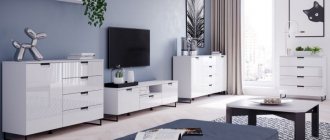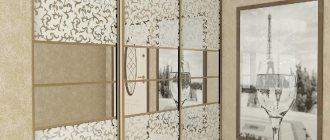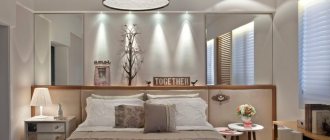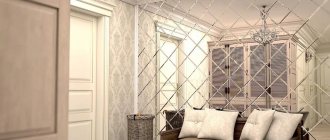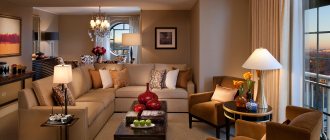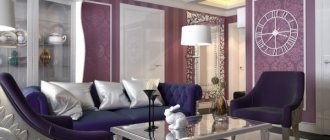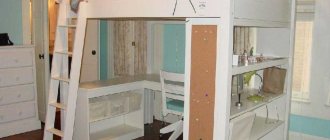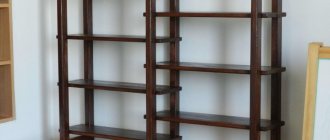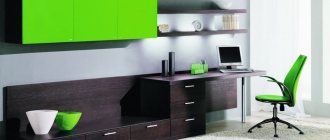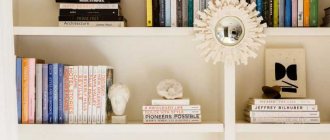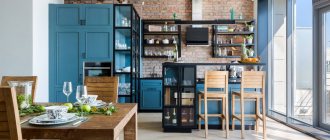It is difficult to imagine the furnishings of any room, be it a residential apartment or an office, without shelves. In addition to their intended purpose, these structures serve as an excellent addition to the interior. Metal, glass or wooden shelves above the table not only greatly expand the functionality of this area, but also add coziness to it. You can purchase them in a specialized store or make them yourself - in any case, you get a simple, but at the same time practical piece of furniture that will be appreciated by all family members.
Product classification
The classification of shelves is based on four main principles that reflect the basic design and consumer properties of these products.
By location
It is the place where the shelves are supposed to be hung that determines their design, as well as their type. Depending on the functional purpose of the room or a separate zone in it, products are placed:
- Above the desk. This model can be used to store office supplies, books or to place decorative items. The main task is to create maximum comfort without standing out from the interior, without distracting a person from the creative process.
- Above the desktop. Functionality is the main task for such a model. Regardless of whose desktop it is, various tools are placed on the surface that should be at hand at any time.
- Above the computer desk. Until recently, a large number of laser discs could be seen here. Now they have been replaced by more compact storage media and cloud technologies, but various gadgets and literature still require storage space, and it is convenient to place them on the shelf above the computer desk.
- Above the dining table. Often shelves in this area can be seen in Provence style interiors. Bottles of wine or olive oil, jars of spices, and various dishes are placed on them, which creates a unique atmosphere of home comfort.
Above the desk
Above the desktop
Above the computer desk
Above the dining table
In addition, shelves can be successfully placed above a table located in a particular room:
- In the nursery. Perhaps, for no room in a house or apartment are hanging shelves more relevant than for a child’s room. The abundance of toys, educational structures and books requires a lot of storage space, and they must be available to their owner at any moment.
- In the kitchen. The shelves in this room are used to store utensils used directly in the cooking process, as well as to place decorative items on them. This is especially true for kitchens that are also used as a dining room.
- In the living room. Traditional items for the living room include audio and video equipment, photo frames, antiques and books. All this, being correctly placed on the shelves, can highlight the taste of the apartment owner in the most favorable way.
- In the bedroom. In this room they can be used both for placing decorative items and for storing various small items; they are usually located above the makeup table.
In a residential apartment or office, any free space above the table can be supplemented with shelves that will be appropriate and organic in the most extraordinary design solutions.
In the nursery
In the kitchen
In the living room
In the bedroom
By type of design
The design of products largely depends on the shape, since not all design options are consistent with constructive capabilities. For example, curved, round or semicircular models often do not have side walls. Classic rectangular, diamond-shaped, triangular - on the contrary, they are simple and provide many design options. The main ones:
- Consoles. Products with a minimalist design, yet very comfortable and functional. Cantilever elements are often made of metal and have a removable structure, which is convenient if you need to change the geometry of the rack.
- Multi-tiered. They are extremely practical, since they allow you to rationally use the space of one conventional square of room area.
- With side walls. They are made in the shape of a niche and are convenient for storing books that do not fall due to the presence of sides. Such models can be equipped with either two or one side wall.
- With a back wall. This design does not greatly affect functionality, but it noticeably changes the overall appearance of the wall on which it is located.
- Universal options. These shelves are simple but functional. As a rule, they have correct geometric shapes, reliable fastenings with a margin of safety, and they can be used for any purpose.
Whatever the design of the shelves, it should always correspond to their functional purpose.
Consoles
Multi-tiered
With side walls
With back wall
Universal
By purpose
The main purpose of the products is the arrangement and storage of small and medium-sized items. However, depending on how they are used and who owns them, the preferred design will also be determined. For example, shelves in a nursery must be safe, which means they must have reliable fastenings that prevent the possibility of falling, rounded corners, and be made from environmentally friendly materials. For boys, it is preferable to install roomy structures where you can put a large toy or model airplane. For girls, more interesting options are those with many small compartments in which you can place your treasures and dolls.
A shelf for a schoolchild or student can have the correct shape and be made in a calm color scheme that will not distract from the learning process. For a young family of two people who do not yet have children, universal designs combined for their intended purpose - the so-called storage systems - will be relevant. Such a rack can have several tiers, while combining open and closed compartments in which you can place household items, as well as display room decor items.
Another option is shelves that serve a decorative function. Such interior items can have different shapes and be made of metal, glass, wood.
Designs for flower pots look no less interesting. Such products are simple and inconspicuous, but flowers or decorative items placed on them radically change the appearance of the room. In such cases, shelves can have several levels.
For schoolchildren
For flowers
As a storage system
Decorative
Depending on installation method
Wall shelves are not only a simple, but also a very versatile piece of furniture. Depending on the installation method, they are divided into:
- Wall-mounted. This is the most common way to place shelves, which makes it possible to effectively use the wall area. There are no downsides to this arrangement, except perhaps for the commonplace.
- Hanging. In contrast to the first, such models are not yet so often found in classic interiors. They can be attached to the ceiling or wall on a suspended structure and organically complement interiors in loft, modern or high-tech styles. This installation method has no disadvantages, but it cannot be used in all rooms.
- Angular. Such shelves allow you to optimally use the internal corner space of the room between two adjacent walls, which is often unused. Elements made of plasterboard in the form of illuminated niches visually add space to the room. Simple rectangular products are suitable for the outer corner. This solution is especially relevant if there are columns in the room, the design of which will make the interior more stylish and extraordinary. One of the disadvantages of the products is the difficulty of manufacturing.
- Tables with add-ons. This design has both advantages, which consist in the ease of moving furniture along with the shelves, and disadvantages, which consist in the inability to change the configuration of products in height or width relative to the position of the table itself.
Also interesting are options for the combined use of shelves, for example, hanging and wall-mounted, as one of the ways to create non-standard solutions in the interior.
Wall mounted
Hanging
Corner
Table with add-ons
Types of shelves
The variety of types of shelves today is very large. If we take as a basis the material from which the shelf is made, then they can all be classified as follows:
- Glass and mirror;
- Wooden (chipboard, MDF, plywood);
- Polymer and plastic;
- From other materials that can be combined with each other.
If we take the design, appearance, structure and method of fastening as a basis, we can distinguish the following types:
Wall mounted
Wall shelves supported by other stable furniture or the floor. A positive feature of such shelves is that their special design allows them to withstand quite a large load, which makes them indispensable assistants in the house when you need a place to store something large and heavy.
Most often they are used for all kinds of equipment or storing shoes in the hallway. These shelves take up minimal space, which is also a positive feature, especially for small apartments.
Classic (rectangular)
Classic rectangular wall shelves attach directly to the wall. The advantage of this structure is that you can use both internal and external surfaces. The back wall may be missing, leaving the wall exposed.
You can put various interior items on top: vases, clocks, photographs, lamps, books, night lights and figurines. It is precisely these shelves that, due to their functionality, add coziness to the apartment.
Multi-tiered
Multi-tiered shelves on the wall look very original and also combine many different functions. This type of shelves can combine a combination of various horizontal, vertical and inclined planes, which turns out to be very convenient in everyday life.
However, they often simply make identical horizontal planes, which, firstly, have an equally beautiful appearance, and secondly, are very functional. In this case, you should give free rein to your imagination to make something that is both comfortable and beautiful, matching both your preferences and the surrounding interior.
Corner
Corner shelves make it possible to use all the empty corners in the apartment. They are most often used in bathrooms, but this type of shelf can be used anywhere. They are reliable and stable. They can even be made transparent, which will look very modern.
Manufacturing materials
Modern manufacturers use a variety of materials to make shelves. It can be chipboard, MDF, acrylic. However, traditional types of raw materials have not lost their relevance:
- Tree. Perhaps the most popular material. Solid wood shelves look great in any interior; they are especially often used in Scandinavian style or in loft-style rooms. In addition, wood has high environmental characteristics, which cannot be said about artificial materials made using glue. There are also some downsides - the cost of the shelves is quite high, since high-quality raw materials are always prestigious, environmentally friendly and expensive.
- Glass. Designs made from this material allow you to create a variety of design solutions based on a combination of the properties of a transparent surface and lighting. Glass is not affected by most aggressive environments, including moisture, is easy to clean and has increased wear resistance. The disadvantage of glass shelves is that they are fragile and traumatic.
- Metal. Steel products are simple and easy to use. Such shelves often have fastenings for installation on metal guides, which allows you to change the configuration of the product if necessary. The disadvantage is their low aesthetic properties, which is more than compensated by their functionality.
- Plastic. Modern manufacturing technologies for building materials make it possible to use plastic panels to make shelves with an almost unlimited choice of textures and colors. Plastic or vinyl products are environmentally friendly, often used in interiors in high-tech and modern styles, where there are non-standard shapes and curved lines. They have few disadvantages, one of them is that under heavy load the product can change shape or bend.
- Chipboard. Perhaps this material can be classified as the most budget-friendly. Chipboard shelves do their job well, but they are very fragile, especially at the fastening points, and have poor environmental performance due to the use of glue in the manufacture of the material.
- MDF. This raw material is most widely used for the manufacture of not only shelves, but also other furniture in Russia and Europe. Compared to chipboard, the material is stronger and more environmentally friendly. When applied, the coating can imitate many textures and have different colors. At the same time, MDF is a budget material and is relatively cheap.
The main characteristic of the material is environmental friendliness, which is especially important in families with children. Therefore, when choosing shelves based on price-quality ratio, emphasis should be placed in favor of the second indicator.
Tree
Glass
Metal
Plastic
MDF
Chipboard
Types of shelves
The variety of types of shelves today is very large. If we take as a basis the material from which the shelf is made, then they can all be classified as follows:
- Glass and mirror;
- Wooden (chipboard, MDF, plywood);
- Polymer and plastic;
- From other materials that can be combined with each other.
If we take the design, appearance, structure and method of fastening as a basis, we can distinguish the following types:
Wall mounted
Wall shelves supported by other stable furniture or the floor. A positive feature of such shelves is that their special design allows them to withstand quite a large load, which makes them indispensable assistants in the house when you need a place to store something large and heavy.
Most often they are used for all kinds of equipment or storing shoes in the hallway. These shelves take up minimal space, which is also a positive feature, especially for small apartments.
Sometimes, in order to make your interior design exceptional, it is not at all necessary to resort to the services of expensive specialists or buy exclusive and expensive furniture. After all, decorating the interior of a room is not a routine task, but the most creative process of transforming space. Therefore, sometimes, to give a room a certain individual style, the most ordinary and simple objects are enough, which with their presence will dilute the monotony of the interior, making it more dynamic and functional. Such elements are racks and wall shelves, when choosing which it is only important to take into account the harmony of their shapes and colors with the surrounding interior, without forgetting about their main functional purpose.
Decorative design
Despite the many design options, there are basic rules that should be followed when creating a decorative or work area with these interior elements. For example, the shelves above the table in the children's room should not be of too bright colors, contain prints with cartoon characters and textures that can distract the child's attention from the main process - studying.
Bright colors in any interior are an irritant, so they should be used only consciously. If it is quite problematic to decide on the choice of shade, it is better to give preference to pastel colors and natural textures - stone, wood.
In order to highlight the shelves, you can resort to a little trick: use brightly colored materials to make the side parts of the product.
When creating a work area for a student, you can use models with cork covering elements so that the student has the opportunity to attach reminder sheets. Options with a built-in chalk board or marker are very popular, which will allow you to use notes and make the interior more interesting.
Shelves above the desk for a schoolchild
Every parent thinks about how to properly design a work area for their child. Modern students do not have room on their desks to accommodate all their notebooks, textbooks, various books, and all kinds of accessories in general.
This is where all sorts of storage system models come to the rescue. They are not only installed near the table, but also secured above the student’s workplace.
A well-designed work area is the main task of parents
Location recommendations
The arrangement of structures can be arbitrary, the main thing is convenient. However, when it comes to placing shelves above a student’s desk, you should follow a few simple rules:
- The hanging structure should not block the light, especially if the workplace is located in a dimly lit area.
- The furniture tabletop and shelves should be positioned in such a way that the child, sitting at the table, is facing or sideways to the doorway. It has been proven that a person sitting with his back to the door experiences discomfort while working.
- The structures must be at a sufficient height from the seated person’s head so as not to reduce the size of the working space. When answering the question about what height to hang the shelf, it is worth noting that its bottom panel should be located at arm's length so that the child can take the desired item without getting up.
There is one more thing to consider before hanging the shelf. It is advisable to place the upper part of the structure at a low height; the person sitting at the table should not have the need to use a chair and other objects to reach the farthest compartments, since this can be traumatic.
In cases where wall furniture elements perform an exclusively decorative function, the height of their location is not important.
Another criterion when choosing a location for a shelf above a table is the amount of free space in the room. For example, multi-tiered or corner models are great for small rooms.
The hanging structure should not obscure the light
The person should sit facing or sideways to the doorway
The structures must be at a sufficient height from the seated person’s head
How to do it yourself
The modern furniture market offers a huge number of shelves of various models and price categories. However, this design is so simple and diverse that you can easily make it yourself. To work you will need:
- drill;
- hacksaw or jigsaw;
- roulette;
- level;
- several screws and dowels;
- shelf fastenings;
- decorative items that can be purchased in specialized retail chains.
The main element for self-production is a wooden board, chipboard or MDF panel. If the craftsman has not previously had experience creating a shelf with his own hands, you can start with a product of the simplest shape - rectangular, made from the most affordable material - a planed wooden board.
The main manufacturing stages will be as follows:
- Preparation of the drawing. There is no need to perform a detailed drawing of each individual element. It is enough to determine the dimensions of the future product, taking into account the place where it will be installed. If it is a wall, use a tape measure to determine the required length and width of the shelf, as well as where to install dowels for fastenings. Then a simple diagram, for example a rectangle, is drawn on a piece of paper, and the length and width of the product are noted in centimeters and millimeters. The drawing indicates the installation locations of fastenings or canopies.
- Making shelf parts. Based on the dimensions of the drawing, four boards are cut to create a top and bottom panel and two side walls of the same length. The edges of the boards should be sanded to remove roughness. To improve the appearance, the material can be coated with stain, which will improve the aesthetic properties of the surface and emphasize the structure of the wood.
- Assembly. The bottom panel is placed on a flat surface, the side walls are alternately applied from the ends and the places where the screws will be screwed in are marked. The side panels should be installed in such a way that their ends are open, and the edges of the bottom and top panels rest against the side walls and are not visible. Having attached the side walls, using a thin drill corresponding in diameter to the self-tapping screws, drill through holes with a recess into the horizontal bottom panel. This is necessary to prevent the board from cracking when screwing in the fasteners. Secure the side walls with self-tapping screws. The same is done with the top panel. As a result, you will get a shelf of the correct rectangular shape.
- Decoration. To give the shelf an attractive appearance and moisture resistance, you can coat it with wood varnish or use the so-called “Yacht varnish”; it costs a little more than usual, but is very resistant to moisture and creates a high-quality glossy finish. After the treatment has dried, you need to install fasteners with which the shelf will be hung on the wall.
- Installation of fasteners and hanging. Before hanging the shelf, the fasteners are installed on the top of the side walls at an equal distance (about 3–5 centimeters) from the top surface. The fasteners should not be mounted on the top panel, as this will reduce the product’s resistance to loads. The workpiece is applied to the wall at the place of its installation, using a level, give it a strictly horizontal position, and with a pencil mark the installation points of the dowels on which the product will be hung. If the wall is wooden, dowels are not required, just screw in the screws. Then, using a hammer drill or impact drill, holes are drilled in the wall and dowels with self-tapping screws are installed. Hang the finished product on the wall.
Making a simple shelf with your own hands is a fairly basic task. But models of more intricate designs using glass or metal are not as complicated as it might seem at first glance. The main thing is the desire to create a truly stylish and functional piece of furniture with your own hands.
Required Tools
Preparation of the drawing
Making shelf parts
Assembly
Decoration
Mounting and hanging
At what height should book shelves be placed in a children's room?
Everything is absolutely individual and here it is not construction that comes to the fore, but genetics.
A seven-year-old child may be below 110 cm tall, or taller than 140 cm, and it’s even difficult to find an average height, because you won’t need it.
Shelves for books can be hanging, wall, or floor.
Shelves can be located above the table and even be structurally one with it (the table).
There is only one guideline and it is absolutely individual. Your child should calmly get a book from the top shelf.
But at the same time, do not rise on tiptoes and do not extend your arm to its full length.
You can choose the height of the shelf yourself.
Ask the child to stand up and stretch his arm up above his head, measure.
The distance from the shoulder to the fingertips was divided by two and subtracted from the size of the risk that is located on the wall.
This will be a convenient distance for the child, that is, he stands near the shelf with his arm extended to half and he can get a book from the top shelf.
We can only speak approximately.
For example, a child’s height is 120 cm, the distance from the floor to the top shelf is from 140 to 150 cm, this is quite normal.
In general, the whole situation is not entirely correct, children grow quite quickly and it is not worth “punching holes” in the walls with constant regularity.
In the end, the necessary books can be rearranged exactly in the place where the child can get them.
Well, practice shows the following:
Almost all the necessary information for the student is on the computer; textbooks are stored in the desk drawer at which the child does his homework.
If they need to get a book, children turn to their parents.
Calculating the necessary centimeters is often completely unnecessary; in the case of a child, children grow.
You might find this table useful:
Here a certain average height of a child is derived, taking into account gender and age. www.remotvet.ru
